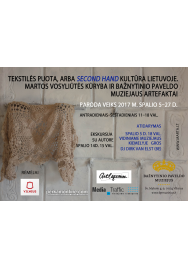2017 09 22
 The appearance of this exhibition has two reasons: the textual one and the visual one.
The appearance of this exhibition has two reasons: the textual one and the visual one.
In 2003, Marta Vosyliūtė, invited to the AICA art critics' conference in Vilnius, read a report on second hand clothing shops, which sparked a massive public outcry. The artist had studied the subject matter by various possible classifications, in various aspects, in her search for the tensions and meanings of the phrase "a five-cent store in a churchyard": she wrote about charity and its Christian aspect, younger children's hereditary clothes, the covered songs, and inspirational sources for designers. 2009 witnessed the grown activity of worn clothing shops, commission stores, and household appliances repair centers: then, it became fashionable to be ecologically mature by recycling the cast-off skins of the past. This was determined by the overall economic situation and lessons in ecology. Even though, in the words of the artist, our relatives living in the countryside have always sorted out all things long before it became so fashionable. Five more years later, every fifth of the city's commercial offices is promoting environmentally friendly products.
Thinking of the fact that we keep living and drowning in information that belongs to both cultural heritage and noise – including the over-expression of classics and minor loudmouths – in 2009, Marta Vosyliūtė began a series of paintings to redefine the notion of heritage: it is the quietness of Algimantas Kuras’ paintings, in which nature very peacefully "eats up" non-aggressive garbage. In the 21st century, the garbage is already much more aggressive: nature will not take it over so easily.
Along with the artist’s paintings, the exhibition also presents her new video films about the processing of worn textile, where she analyzes the existence of home-made capitalism and cultural clichés. The pilgrims no longer need to stroll around, because their boots have already visited the whole world: they were made in Cambodia and thrown away in London, where they were collected by Lithuanian logistics specialists. Today, flaneurs would rather idle about online than outside. Vosyliūtė’s video installations display factories and hangars, the quiet and monotonous work of focused women, which affects her like the church preparations for the feast day. If they relax for at least a minute, they will cut off their fingers. Freedom employs you.
For the exhibition, Marta Vosyliūtė and the Church Heritage Museum have selected six liturgical vestments, whose history and iconography is in line with the image of the "textile feast": some obviously apply used fabrics, providing them with a new shape and quality, while other robes are "pilgrims", made from exotic fabrics that come from Far East. In this way, the artworks show that journeys of fabrics constitute an old historical phenomenon, where the garments on their own turn into storytellers who reveal to the viewer the inventiveness and artistic taste of the fashion designers of liturgy vestments. One more specific feature of remaking ecclesiastical embroidery and ritual clothing is the commemoration of family relics or relatives: for example, a dead warrior’s widow has donated her husband’s uniform jacket to sew a church vestment.
"A Textile Feast" is a mixed exposition of artifacts by the Church Heritage Museum and Marta Vosyliūtė, where several centuries-old religious clothing and family relics hold discussions with new costumes featuring authorial designs that combine machine and hand work. The exhibition takes place in the impressive basement of the museum, allowing viewers to feel inside a true storehouse of stories, fate and fortunes.
Old clothes in the attic;
by remodeling some, they would suffice
to last to the end of life. *
* Giedrė Kazlauskaitė, "Learning to Sew"
The exhibition will be open until October 27, 2017.
On October 14 and 16, at 3 p.m., the author of the artworks will show around the exhibition.
Exhibition organizers: Marta Vosyliūtė and the Church Heritage Museum.
Sponsors: the Archdiocese of Vilnius; Vilnius City Municipality.
Get more information at: tel. (+370) 5 269 7800, e-mail: museum@bpmuziejus.lt,
 The appearance of this exhibition has two reasons: the textual one and the visual one.
The appearance of this exhibition has two reasons: the textual one and the visual one.
 The appearance of this exhibition has two reasons: the textual one and the visual one.
The appearance of this exhibition has two reasons: the textual one and the visual one.